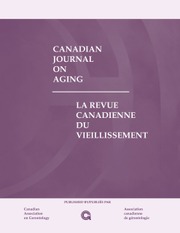Article contents
Les besoins non comblés de services à domicile chez les aînés canadiens*
Published online by Cambridge University Press: 10 August 2012
Abstract
Based on data from the 2002 General Social Survey, this research presents a global portrait of unmet needs for home care services among Canadians aged 65 and over. It shows that 26.8% of seniors need assistance, accounting for approximately 1,024,000 individuals. Among these, just over 180,000 (17.7%) had at least one unmet need. In nearly half the cases, elderly with unmet needs receive insufficient support for 2 activities or more. Furthermore, house cleaning, house maintenance and outdoor work are the three activities with the highest prevalence of unmet needs. Finally, the younger seniors, those who require assistance for 3 or 4 activities and those living in Quebec and British Columbia are most likely to have unmet needs.
Résumé
S’appuyant sur les données de l’Enquête sociale générale 2002, cette recherche brosse un portrait global des besoins non comblés (BNC) de services à domicile parmi les Canadiens âgés de 65 ans et plus. Il en ressort que 26,8% des aînés ont besoin d’assistance, soit environ 1 024 000 individus et que, parmi ceux-ci, un peu plus de 180 000 (17,7%) ont des BNC. Dans près de la moitié des cas, ces individus avec des BNC reçoivent une aide insuffisante pour au moins 2 activités. Par ailleurs, les travaux ménagers, l’entretien de la maison et les travaux extérieurs sont les trois activités où l’on retrouve la plus grande prévalence de BNC. Enfin, les aînés les moins âgés, ceux ayant besoin d’assistance pour 3 ou 4 activités et ceux habitant le Québec et la Colombie-Britannique sont les plus susceptibles d’avoir des BNC.
Keywords
- Type
- Articles
- Information
- Canadian Journal on Aging / La Revue canadienne du vieillissement , Volume 31 , Issue 3 , September 2012 , pp. 271 - 283
- Copyright
- Copyright © Canadian Association on Gerontology 2012
Footnotes
Nous aimerions remercier Mme Janice Keefe et son équipe du Mount St-Vincent University (MSVU) financée par les Instituts de recherche en santé du Canada (IRSC) pour leur soutien intellectuel et pécuniaire. Merci également à Mme Joëlle Gaymu pour la supervision d’un stage de M-A Busque à l’Institut national d’études démographiques (Ined) financé par le Population Change and Lifecourse Strategic Knowledge Cluster.
References
Bibliographie
- 7
- Cited by


